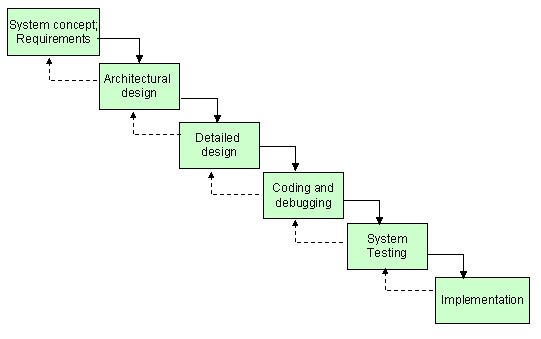Application Development Methods |
HOME |
|
A project typically has
The organization includes a steering group and the project team. A project is realized in several phases which are separated by decision points. Project is different from routine work of an organization by being a separate, well-defined entity which is done only once.
Typically, a consultant's work is organized by a project, especially when it will result in a product like a report, or a software product. Its characteristics:
Application areas: research, software production, hardware production, development, restructuring of an organization, starting of a new activity.
Project control: external by a steering group/ support group/ sponsor, internal by project manager.
Project organization: project team, project manager, support group (outside expertise and/or user views), information group (test group of clients).

Information system development is traditionally based on systems approach: the target organization or process is seen as a system. A system can be described by describing its parts and the interaction between the parts. It is a well-defined structure, and it has clear rules.
The waterfall model of systems development

Systems development project: phases
1. The project definition should include:
1.1 Description of the present system, if one exists, manual and computerized:
1.2 Reasons for the project:
1.3 Goals and draft description of desired system:
1.4 General frame for schedule and budget, participants
1.5 Reference materials which will be used for the project
A good project plan means that you have broken down the project into meaningful activities (or phases), and the activities further into manageable tasks. Each task much be described with appropriate detail. Identify any dependencies between activities that may be critical and cause possible delays in project schedule.
Each activity must end with a deliverable. Additionally, you have to define milestones at which the project progress can be evaluated. The milestones can be e.g. the completion of activities related to one objective, or phase, or a major deliverables of the project.
2.1 Project Schedule
Project schedule presents the estimated duration of each activity and task. The recommended method of presenting the schedule is the Gantt chart which can be produced with a spreadsheet or project management software.
The task assignments show who is going to do what. Each activity should have a responsible team member ("co-ordinator") and each task member(s) who contribute to it. The task assignments can be presented on a separate sheet or combined with the work breakdown structure.
3 Systems analysis
The description of the information processing is done in detail.
There are formal methods
which can be applied. Some are based on flowcharts:
information flows and information contents are analyzed.
Others are concept analysis, organization charts,
decision matrixes, etc. The system is divided into
subsystems if needed.
If the development of a new data processing system is done by IT professionals only, the users may feel alienated. In addition to user interviews and user representation in project team, organization development seminars, quality groups and self-development of systems are used.
The hardware and software are defined and purchased:
- definition of system features
- desired properties of the hardware and software are set
- call for tenders to selected suppliers
- comparison of tenders and negotiations
- contract.
In Web site development you need to plan the following:
3.1 Site structure and navigation
3.2 User interface
3.3 Processes and functions: flowcharts
3.4 Information contents: analysis of information, creation and updating
3.5 Technical design needs
3.6 Technical architecture
4 System design
The system design for a new system includes
Prototyping is a good method, in particular, if the users cannot describe their needs and wishes exactly in an early phase of the system development. A prototype is a look-a-like model of the system which is done quickly to demonstrate features of a real system. The entry-forms and display screens are designed like they were part of a full system, but the processing part is not completed yet.
5 System development
System development tools, version control, application generators, programming languages.
Installation of hardware and software.
Actual programming, data base design, data collection and entry.
Testing
Documentation.
6 Implementation, training of users and maintenance.
7 Evaluation of the project and its results.
![]()
| Created by: Jaana Holvikivi | Last update: 9.1.2016 |